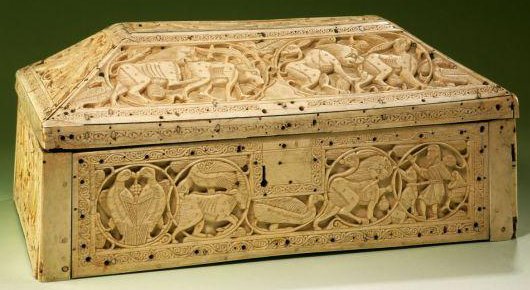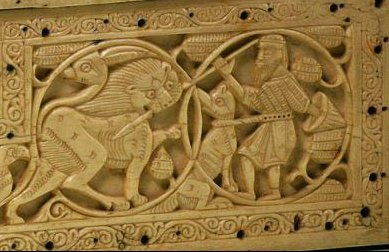Shop Amazon - Create an Amazon Baby Registry

Try Amazon Audible Plus
Ivory casket, Fatimid Sicily or Southern Italy, 11th-12th Centuries

A larger image of this Ivory casket, Fatimid Sicily or Southern Italy, Museum of Islamic Art at the Pergamon Museum, Berlin, Germany. K 3101.
Rear view of the casket.

A rectangular casket, with a desk-like lid, made of individual pieces of ivory that have been joined together. The lid is attached by two silver clasps/hinges, which were made at a later date, and the padlock has been lost. Various holes that have been bored through the casket demonstrate its chequered history and the possibility that it had an indefinite number of iron fittings. The bottom excepted, the entire box is covered in decorative animal-motif friezes, which are framed by narrow bands of tendrils of half-palmettes. Animals and animal fights, composed in both a stylised and a freehand form, are found on the panels. Circular tendrils overlap the animals. A great variety of animals are represented: lions, hares, ibex, stags, camels, giraffes and birds. Mythological creatures such as griffins are also included. The animals are portrayed as fighting one another or as being pursued by hunters. The human figures appear as hunters or camel leaders. One of the caskets from the Egyptian group, of which this one is part, states in Latin script the name of one of its patrons, which leads to the assumption that these caskets could have been made by Arab craftsmen, working in the Fatimid tradition in southern Italy, on the commission of wealthy patrons. The animals belonging to this group bear such a close resemblance to those on a group of oliphants that it is possible that the workshops produced both caskets and oliphants.
A similar stylistic depiction of animals can also be seen on 11th-12th century buildings in southern Italy, so it can therefore be assumed that the animal motifs held a particular fascination in Europe as well.
Date: Hegira 5th-6th centuries / AD 11th-12th centuries.
Period / Dynasty: Fatimid.
Region: Sicily or southern Italy.
Museum of Islamic Art at the Pergamon Museum, Berlin, Germany. Museum Inventory Number: K 3101. Source: Museum with no Frontiers
Referenced on p.268, Arms and Armour of the Crusading Era, 1050-1350, Western Europe and the Crusader States by David Nicolle
706 Carved and painted ivory box, Sicily, late 12th/early 13th centuries
(Staatliche Museum Dahlem, Berlin, Germany)
Clearly the workmanship of the Muslim ivory workers of Sicily had declined by the end of Norman rule, but the subjects they illustrated remained the same. Here a lion-hunter carries a long spear and a deeply convex shield while wearing a short-sleeved mail hauberk which probably continued inside his kilt.
Previous: Carved ivory horn or 'oliphant' from Sicily, Musée Crozatier, Le Puy, France Next: Figure with Goblet on Fatimid Bowl, 11th-12th century, Islamic Museum, Cairo
A Sicilian Saracen in Armies of Feudal Europe 1066-1300 by Ian Heath, based this Ivory casket, Pergamon Museum
See also Fatimid Illustrations of Soldiers and Hunters, 10th - 12th Centuries



